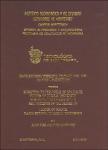| dc.contributor.advisor | Bonilla Ríos, Jaime | |
| dc.creator | Aguirre González, Juan José | |
| dc.date.accessioned | 2015-08-17T09:59:55Z | en |
| dc.date.available | 2015-08-17T09:59:55Z | en |
| dc.date.issued | 2000-05-01 | |
| dc.identifier.uri | http://hdl.handle.net/11285/568441 | en |
| dc.description.abstract | In the present study a rheological analysis of the polymer melt history inside a concentric annular die of
an extrusion blow-molding machine was studied using momentum and continuity balances for six high
density polyethylene (HDPE) resins to determine the pressure rise and thickness swell. It also tried to
develop a laboratory technique to predict die swell during blow molding.
The rheological measurements included oscillatory behavior, relaxation modulus, steady state behavior,
and capillary flow. They were used to generate material functions that were compared to predictions from
the Wagner constitutive model and to blow molding processability data.
A modified damping function was developed and used in the prediction of steady state elongational
viscosity. | |
| dc.language | eng | |
| dc.publisher | Instituto Tecnológico y de Estudios Superiores de Monterrey | |
| dc.rights | info:eu-repo/semantics/openAccess | |
| dc.rights.uri | http://creativecommons.org/licenses/by-nc-nd/4.0 | * |
| dc.subject.classification | Area::CIENCIAS FÍSICO MATEMÁTICAS Y CIENCIAS DE LA TIERRA::FÍSICA::FÍSICA DE FLUÍDOS::FENÓMENOS DE ALTA PRESIÓN | es_MX |
| dc.title | Blow Molding Modeling: Pressure Rise and Die Swell Predictions-Edición Única | en |
| dc.type | Tesis de maestría | |
| dc.contributor.department | Campus Monterrey | en |
| dc.contributor.committeemember | Daumerie, Michel | |
| dc.contributor.committeemember | Romero, Miguel Angel | |
| dc.contributor.mentor | Viramontes, Federico | |
| refterms.dateFOA | 2018-03-25T05:29:34Z | |
| refterms.dateFOA | 2018-03-25T05:29:34Z | |
| html.description.abstract | In the present study a rheological analysis of the polymer melt history inside a concentric annular die of
an extrusion blow-molding machine was studied using momentum and continuity balances for six high
density polyethylene (HDPE) resins to determine the pressure rise and thickness swell. It also tried to
develop a laboratory technique to predict die swell during blow molding.
The rheological measurements included oscillatory behavior, relaxation modulus, steady state behavior,
and capillary flow. They were used to generate material functions that were compared to predictions from
the Wagner constitutive model and to blow molding processability data.
A modified damping function was developed and used in the prediction of steady state elongational
viscosity. | |
| dc.identificator | Campo||1||22||2204||220406 | |



